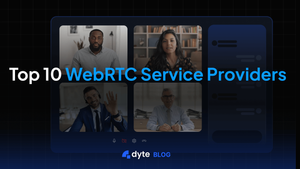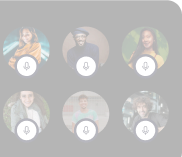From video calls and instant messaging to live broadcasting and interactive gaming, individuals and businesses alike rely on seamless, immediate connections. At the heart of these interactions lies Web Real-Time Communication (WebRTC), a groundbreaking technology that enables direct, peer-to-peer communication through web browsers without the need for additional plugins or applications.
As we navigate, the landscape of WebRTC providers has evolved significantly, with numerous players offering a variety of services tailored to diverse needs. Whether you're a startup looking to integrate live video features into your app, an enterprise in search of a scalable conference solution, or simply curious about the technology powering modern communication, understanding the options available is crucial.
This article aims to provide a comprehensive list of WebRTC providers, exploring their unique offerings, strengths, and how they're pushing the boundaries of real-time communication. We'll dive into the evolution of WebRTC technology, highlight key features to consider when selecting a provider, and offer insights into the top contenders in the space. By the end, you'll have a clearer picture of the WebRTC landscape, empowering you to make informed decisions that align with your communication needs and goals.
Evolution of WebRTC
WebRTC, short for Web Real-Time Communication, originated from the foundational work of Global IP Solutions (GIPS) in Sweden around 1999, focusing on real-time communication software. Google's acquisition of GIPS in 2010 marked a pivotal moment, setting the stage for integrating real-time communication capabilities directly into web browsers, which led to the development of WebRTC.
Over the years, WebRTC underwent significant refinements, including the development of crucial components like the RTCPeerConnection API, to ensure consistency and reliability across different browsers. This effort towards standardization culminated in its official recognition as a standard by the World Wide Web Consortium (W3C) and the Internet Engineering Task Force (IETF), highlighting its importance and paving the way for widespread adoption in various applications.
Today, WebRTC is a key technology enabling a wide range of applications, from video conferencing to interactive gaming, by allowing direct, peer-to-peer communication without external plugins. Its ongoing evolution, driven by the WebRTC Working Group, continues to explore new use cases and enhancements, ensuring that WebRTC remains at the forefront of digital communication technology.
Key Features to Look for in a WebRTC Service Provider
Selecting the right WebRTC service provider is crucial for businesses and developers aiming to integrate real-time communication capabilities into their applications. As the technology has matured, the landscape of providers has become increasingly diverse, each offering a unique set of features and services. Here are key features to consider when evaluating WebRTC providers to ensure you choose a solution that aligns with your specific needs and goals:
- Ease of Integration: A provider should offer comprehensive documentation and SDKs (Software Development Kits) that facilitate smooth integration with various platforms and programming languages. The easier it is to integrate the technology into your existing systems, the faster you can go to market and the lower the overall development cost.
- Scalability: As your user base grows, your WebRTC solution must be able to scale accordingly. Look for providers that offer cloud-based infrastructure or scalable peer-to-peer networking capabilities to handle increasing loads without compromising on performance or reliability.
- Latency and Quality of Service: Low latency and high-quality audio/video transmissions are critical for a seamless user experience. Providers that utilize efficient codecs, global server distribution, and adaptive bitrate streaming can significantly enhance the quality of real-time communications.
- Security and Privacy: Given the sensitive nature of real-time communications, security cannot be overlooked. Opt for providers that implement end-to-end encryption, secure authentication mechanisms, and compliance with data protection regulations like GDPR to safeguard user data and privacy.
- Cross-Platform Compatibility: In today's multi-device world, ensuring your application works seamlessly across different browsers, operating systems, and devices is essential. Providers that offer cross-platform support and regularly update their SDKs for compatibility will help maximize your application's reach and usability.
- Customization and Control: Flexibility in customizing video and audio streams, UI/UX elements, and communication protocols can help tailor the user experience to meet specific requirements. Providers that offer extensive APIs and control over the communication flow enable more personalized and differentiated applications.
- Reliable Technical Support and SLAs: Strong technical support and service level agreements (SLAs) are indicators of a provider's commitment to their service's reliability and customer success. Access to expert assistance and guaranteed uptime can be pivotal, especially for mission-critical applications.
- Analytics and Monitoring Tools: Providers that include robust analytics and monitoring tools give valuable insights into usage patterns, call quality metrics, and system performance. These insights can drive data-driven decisions to optimize and enhance your application over time.
When evaluating WebRTC providers, considering these key features will help you choose a solution that not only meets your immediate needs but also supports your long-term vision and growth. The right provider will be a partner in delivering high-quality, real-time communication experiences to your users.
Here's a list of must-have features in a Video SDK
List of Top 10 WebRTC Service Providers:
Top 10 WebRTC Service Providers are Dyte, Zegocloud, Agora, Vonage, AWS Chme, Twilio Video, MirrorFly, Digital Samba, Daily and Jitsi
- Dyte
- Zegocloud
- Agora
- Vonage
- AWS chime
- Twilio Video
- Mirrorfly
- Digital Samba
- Daily
- Jitsi
Let's evaluate features, limitations, and pricing for each of them.
Dyte
Dyte, a robust video SDK platform leveraging WebRTC, enables businesses of all scales to effortlessly incorporate top-notch live video features into their apps. Its standout feature is the unparalleled flexibility and customization it offers, empowering users to tailor the live video solution to their exact requirements. Dyte's Video SDK excels in call quality and scalability, supported by a foundation across various cloud providers.
Features:
- Extensive collaborative functionalities: Dyte presents an array of engaging options, including messaging, emotive reactions, surveys, and the ability to share documents, thus improving user interaction.
- Accessible APIs: The service offers readily available APIs, facilitating the integration of its video SDK into your app with ease.
- In-depth insights: The platform enables users to obtain comprehensive analytics concerning different aspects of video calls.
- Multi-platform broadcasting: Thanks to integrated RTMP support, Dyte enables broadcasting across a variety of platforms such as YouTube, LinkedIn, Facebook, and others.
- Superior communication quality: Dyte ensures smooth, uninterrupted audio and video communication for all participants.
Pricing for Dyte:
Dyte's pricing strategy is tailored to accommodate businesses big and small, providing 10,000 minutes for free each month. Additional usage costs $0.001 per minute per user for Voice Conferencing and $0.004 per minute per user for Video Conferencing. The platform is celebrated for its user-friendly interface, broad range of features, attractive pricing, outstanding customer service, and active community. It guarantees secure streaming through encryption, ensuring your data remains confidential and protected. For customized pricing options, you can get in touch with Dyte's Product Team or start building with your 10,000 free credits.
Zegocloud
Zegocloud is a cloud-based communication platform that offers WebRTC functionalities through its APIs and SDKs. This allows developers to easily integrate real-time features like video chat, voice calls, and live streaming into their web and mobile applications.
Features:
- Cross-Platform Compatibility: SDKs often support multiple platforms and devices, including web, mobile, and desktop.
- Analytics: Integration of analytics tools for monitoring video usage and user engagement.
- Video Recording: Ability to capture and record video content.
Limitations:
- Scalability Issues: Difficulty in supporting a large number of users simultaneously due to the peer-to-peer model.
- Bandwidth Limitations: Quality of communication can be affected by users' bandwidth constraints since bandwidth requirement is pretty high.
- Stability and Timeliness: Peer-to-peer connections may face stability issues and challenges in maintaining real-timeness.
- Limited Customization: Constraints in the peer-to-peer model and WebRTC standards may restrict service customization.
- Complex Setup: Technical complexity in configuring WebRTC solutions can be a barrier for some businesses.
- Broadcast Quality: High-quality broadcasts to large audiences may suffer in the peer-to-peer model.
- Data Consumption: Significant data usage might pose concerns for users with limited or expensive internet access.
Pricing:
Zegocloud has a free tier for exploration and pay-as-you-go plans starting at $0.99 per 1,000 video minutes.
Agora
Agora is a cloud-based communication platform offering WebRTC functionalities through its APIs and SDKs. This let’s developers integrate real-time features like video chat, voice calls, and live streaming into their web and mobile applications.
Features:
- Real-time communication: Video chat, voice calls, live streaming.
- Scalability: Supports a large number of concurrent users for various applications.
- Customization: Provides white labeling and UI/UX customization options.
- Additional features: Screen sharing, noise cancellation, recording, and more.
Limitations:
- Customization Complexity: While Agora provides customization options, developers aiming for highly tailored solutions may find the process intricate, requiring a deeper understanding of the platform.
- Geographical Availability: Users in certain regions may experience variations in service quality or availability, as Agora's performance can be influenced by the geographical distribution of its data centers.
- Integration Time: Agora generally requires more than 3 months for SDK integration, which might be a significant time investment for some developers or companies
Pricing
Agora's Video SDK pricing starts with a generous offer of the first 10,000 minutes free each month. For video calling, prices then increase to $3.99 per 1,000 minutes for HD quality and $8.99 per 1,000 minutes for Full HD quality.
Learn more about List of top Agora alternatives, Agora pricing and Compare Dyte vs. Agora
Vonage
Vonage Video is a cloud-based WebRTC solution from the communication giant, Vonage. It allows developers to integrate real-time features like video chat, voice calls, and live streaming into their web and mobile applications using APIs and SDKs.
Features:
- Real-time communication: Video chat, voice calls, in-app messaging, and live streaming.
- Large-scale broadcasting: Reach up to 16,000 concurrent viewers in real-time.
- Customization: White labeling, UI/UX customization, and advanced branding options.
- Security: Built-in security features and compliance with industry standards.
- Additional features: Screen sharing, recording, noise cancellation, and more.
Limitations:
- Limited customization options: While offering white labeling and basic UI/UX customization, Vonage Video might not provide the level of granular control compared to some other WebRTC providers.
- Recording Time: The maximum video recording time has been extended to 240 minutes, indicating previous limitations on meeting and session lengths.
- Integration complexity: Integrating Vonage Video might require more complex development efforts compared to simpler WebRTC solutions, especially for advanced customizations.
Pricing:
Vonage Video's pricing implements a usage-based model, charging $0.00395 per participant, per minute. This approach allows for dynamic calculation of costs based on the actual usage during video sessions. Additionally, Vonage Video offers plans starting at $9.99, which include 2,000 minutes of usage, catering to different levels of demand and providing flexibility for various user needs. This structure is designed to accommodate both small-scale interactions and larger, more intensive video communication requirements
Learn more about the List of top Vonage alternatives, Vonage pricing and compare Dyte vs Vonage (Tokbox)
AWS Chime
AWS Chime is a WebRTC solution offered by Amazon Web Services, that allows developers and businesses to integrate powerful real-time communication capabilities into their applications. AWS Chime provides a platform for building applications that demand high-quality audio and video communication.
Features:
- Real-time communication: Video conferencing, voice calls, screen sharing, and text chat.
- Enterprise-focused features: Call recording, transcription, and analytics.
- Seamless integration: Integrates with other AWS services like S3 and IAM.
- Global network: Delivers reliable connections across multiple regions.
- Security: Built-in security features and compliance with industry standards.
Limitations:
- Scalability: While suitable for small to medium-sized meetings, it may face challenges in handling very large events efficiently.
- Feature Updates: Compared to competitors, AWS Chime's pace of rolling out new features and updates may be slower, affecting user experience over time.
- Complex integration: Integrating Chime might require additional development effort compared to simpler WebRTC solutions.
- Integration Challenges: While AWS Chime integrates well with other AWS services, users may encounter challenges when integrating with non-AWS components, necessitating careful planning.
Pricing:
AWS Chime SDK pricing is based on a pay-as-you-go model, charging $0.0017 per minute per attendee for standard sessions, and $0.0034 for high-definition sessions. Additionally, PSTN Audio Application usage incurs a fee of $0.002 per minute. This flexible pricing structure allows users to pay only for the services they utilize, making it an adaptable solution for integrating communication features into applications
Learn more about the List of top AWS Chime alternatives, AWS Chime pricing and compare Dyte vs.Twilio Video vs. AWS Chime
Twilio Video
Twilio Video was a well-known name in the realm of WebRTC providers, offering developers a platform for integrating real-time video capabilities into their applications. However, Twilio is sunsetting its Twilio Programmable Video and is scheduled to go offline by 5th Dec, 2024.
Features:
- Real-time communication: Video chat, voice calls, live streaming, and screen sharing.
- Global network: Delivers reliable connections across multiple regions.
- Scalability: Supports a large number of concurrent users for various applications.
- Customization: Provides white labeling and UI/UX customization options.
- Additional features: Virtual backgrounds, recording, noise reduction, and more.
Limitations:
- Development Effort: Requires development effort to integrate and customize within applications.
- Bandwidth Requirements: High-quality video calls can consume significant bandwidth, potentially affecting performance in low-bandwidth scenarios.
- Limited Browser Compatibility: While improving, some features may still have limited support across all web browsers, affecting user experience.
- Potential Latency Issues: Users in remote locations might experience latency, impacting the real-time aspect of communication.
Pricing:
Twilio Programmable Video offers diverse pricing, including $0.0015 per minute for peer-to-peer rooms and $0.01 per participant per minute for Group Rooms. It provides 10 GB of free storage, with additional space at $0.05 per GB monthly. Voice services start at $0.0085/min for receiving calls.
Learn more about the List of top Twilio Video alternatives, Twilio Video pricing and compare Dyte vs.Twilio Video
MirrorFly
MirrorFly is a cloud-based WebRTC platform catering primarily to niche businesses. It offers developers APIs and SDKs to integrate real-time features like video chat, voice calls, and chat functionalities into their web and mobile applications.
Features:
- Real-time communication: Video chat, voice calls, and in-app chat.
- Self-managed and cloud-hosted options: Choose the deployment model that best suits your needs.
- Pre-built UI components: Streamline development with ready-made UI elements.
- Additional features: Screen sharing, recording, and real-time translations.
Limitations:
- Integration Complexity: Might require significant development effort for full customization.
- Limited Documentation: Some developers have reported the need for more comprehensive documentation.
- Feature Set Maturity: Depending on specific use cases, certain advanced features or functionalities might still be evolving, requiring users to consider feature maturity for their application requirements.
Pricing:
While MirrorFly offers a free tier, pricing details for paid plans are not publicly available. It's recommended to contact their sales team for specific quotes and plan comparisons based on your project's requirements. This ensures you get the most suitable plan and avoid any pricing surprises.
Digital Samba
Digital Samba is a cloud-based WebRTC platform offering developers the tools to integrate real-time features like video chat, voice calls, and live streaming into web and mobile applications.
Features:
- Real-time communication: Video chat, voice calls, live streaming, and screen sharing.
- Scalability: Supports a large number of concurrent users for various applications.
- Additional features: Recording, transcription, AI features like noise reduction and background blur.
Limitations:
- Complex Features: Some features may be challenging to use due to their complexity.
- Lack of Guides: The absence of video or manual guides makes it harder for users to navigate and utilize the software effectively.
- Limited Free Version: The free version of Digital Samba comes with restrictions on features and participant numbers.
- Customer Support: Access to comprehensive customer support may be limited, especially in lower-tier plans.
Pricing:
Digital Samba's pricing model begins with a platform fee of €99/month. Beyond the 10,000 free participant minutes, additional audio and video usage incurs a cost of €0.004 per minute. Once users exceed the complimentary 60 minutes of recording, charges of €0.013 per minute for extra cloud recording and €0.003 per minute for cloud storage apply. Transcription services are available at €0.023 per minute.
Daily.co
Daily.co offers a cloud-based WebRTC platform that allows developers to integrate real-time features like video chat, voice calls, and live streaming into their web and mobile applications. They claim to have easy-to-use APIs, pre-built UI components, and a global network.
Features:
- Real-time communication: Video chat, voice calls, live streaming, and screen sharing.
- Developer-friendly: Offers well-documented APIs, pre-built UI components, and detailed tutorials.
- Customization: Provides white labeling and basic UI/UX customization options.
- Additional features: Recording, virtual backgrounds, AI noise reduction, and more.
Limitation:
- Customization Restrictions: Although Daily's Video SDK allows for customization, there might be constraints on how deeply you can customize the UI and UX in certain plans, possibly affecting brand consistency.
- Browser Compatibility: While Daily's Video SDK supports most modern browsers, there might be limitations or performance issues in less common or outdated browsers, affecting user experience.
- Limited Control Over Infrastructure: Users have limited control over the underlying infrastructure, which might affect organizations with strict compliance or data residency requirements.
- Support Response Times: Depending on the plan, support response times can vary, which might not meet the needs of projects requiring immediate assistance.
Pricing:
Daily's Video SDK offers an array of pricing options to accommodate diverse needs, including video and audio calls at $0.004/minute, audio-only calls at a reduced rate of $0.00099/minute, and cloud recording services at $0.01349. For those interested in interactive live streaming and RTMP live streaming, specific rates can be discussed directly with Daily.co, with RTMP streaming priced at $0.015 per minute.
Learn more about Daily’s Pricing and here’s a list of Daily alternatives in case you are looking.
Jitsi
Jitsi is an open-source platform that offers a range of WebRTC-based communication services, enabling users to engage in video conferencing, voice calls, and instant messaging.
Features:
- Open Source: It’s free to use and modify, offering transparency and customization options.
- Multi-Platform Support: Works seamlessly on web browsers, desktop applications, and mobile apps.
- High Scalability: Capable of handling large numbers of participants without significant degradation in performance.
- Screen Sharing: Allows users to share their screens during calls, facilitating presentations and collaborative work.
- Recording and Live Streaming: Provides options for session recording and broadcasting to larger audiences.
Limitations:
- Setup Complexity: The initial setup and deployment can be complex for those without technical expertise.
- Variable Video Quality: Video quality can fluctuate based on the user's internet, location, and server capacity.
- Limited Support: Being open-source, support relies heavily on community forums and documentation.
- Self-hosting complexity: Requires technical expertise and resources to set up and maintain your own server infrastructure.
- Dependency on Server Infrastructure: Self-hosted instances of Jitsi require users to manage their server infrastructure, which may be a consideration for those without dedicated IT support.
Pricing:
Jitsi itself is free and open-source, meaning there are no licensing fees involved. However, if you choose to use a hosted Jitsi solution or require additional features and support, costs will vary depending on the provider and chosen plan. It's recommended to explore options from various Jitsi hosting providers to find a solution that meets your needs and budget.
Learn more about Jitsi alternatives and Jitsi pricing
Compare top 10 WebRTC Service Providers
| WebRTC Provider Name | Features | Limitations | Pricing |
| Dyte | Extensive collaboration features, in-depth analytics, video chat, voice calls, live streaming, screen sharing, chat | Limited free tier | Free tier, $0.001/min/user for voice, $0.004/min/user for video |
| Zegocloud | Video chat, voice calls, live streaming | Potential limitations for large-scale events, not specified on ease of use, scalability issues, bandwidth limitations, stability and timeliness issues, limited customization, complex setup, broadcast quality concerns, significant data consumption | Free tier, pay-as-you-go plans |
| Agora | Video chat, voice calls, live streaming, high-definition and full-HD video options, white labeling, UI/UX customization options | Not as easy as some options, customization complexity, geographical availability, integration time | Free tier, pay-as-you-go plans, starts at $3.99 per 1,000 minutes for video calling |
| Vonage Video | Video chat, voice calls, live streaming, in-app messaging, large-scale broadcasting (up to 16,000 viewers), white labeling, UI/UX customization options, advanced branding | Limited customization options, recording time limitations, integration complexity | Usage-based, $0.00395/participant/min, plans starting at $9.99 |
| AWS Chime | Video conferencing, voice calls, screen sharing, chat, text chat, enterprise-focused features (call recording, transcription, analytics), global network | Scalability limitations for very large events, slower feature updates, complex integration, integration challenges | Pay-as-you-go, $0.0017-$0.0034/min/attendee |
| Twilio Video (Sunset) | Video chat, voice calls, live streaming, screen sharing, white labeling, UI/UX customization options | Development effort, bandwidth requirements, limited browser compatibility, potential latency issues (sunset Dec 2024) | Diverse plans, $0.0015-$0.01/min |
| MirrorFly | Video chat, voice calls, in-app chat, self-hosted and cloud-hosted options, pre-built UI components, screen sharing, recording, real-time translations | Potentially complex for full customization, limited documentation, feature set maturity | Not publicly available, contact sales |
| Digital Samba | Video chat, voice calls, live streaming, screen sharing, recording, transcription, AI features (noise reduction, background blur) | Complex features, lack of video/manual guides, limited free version, limited customer support in lower tiers | Platform fee €99/month + usage costs, €0.004/min for audio/video usage beyond free tier |
| Daily.co | Video chat, voice calls, live streaming, screen sharing, developer-friendly (well-documented APIs, pre-built UI components), white labeling, basic UI/UX customization options, recording, virtual backgrounds, AI noise reduction | Customization restrictions in certain plans, browser compatibility limitations, limited control over infrastructure, support response time variations | Pay-as-you-go, $0.004/min for video/audio, $0.00099/min for audio-only, $0.01349 for recording, contact sales for live streaming |
| Jitsi | Video conferencing, voice calls, chat, open-source (free to modify), multi-platform support, high scalability, screen sharing, recording, live streaming | Complex setup for non-technical users, variable video quality, limited support, self-hosting complexity, dependency on server infrastructure | Free, costs for hosted solutions vary |
Conclusion
WebRTC is the backbone of today's video calls. But, despite its strengths, it has challenges of its own.
Unless you have the technical expertise & resources, the integration can be cumbersome.
That's why teams prefer to integrate Managed WebRTC like Dyte over Raw WebRTC.
So check out Dyte because, unlike Raw WebRTC, Dyte actually allows developers to create live experiences in under 5 minutes.
Don't believe us? Check out Dyte's Quickstart guide and explore the sample apps built on top of Dyte.




